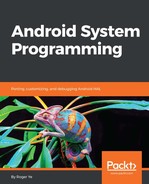Android emulator has been changed dramatically as well in Android 4, 5, 6, and 7. Before Android 5, Android emulator was built on a virtual hardware reference board called goldfish.
The goldfish virtual hardware platform was built on QEMU 1.x to emulate ARM devices on the x86 environment. The x86 host environments could be a Windows, Linux, or macOS X computer. Since the target device architecture is emulated using QEMU, the performance is poor. The emulator is very slow and difficult to use for application developers. However, QEMU is actively developed on the x86 architecture and widely used together with various virtualization technologies, such as VT-x, AMD-V, and so on.
Since Android 4.x, Intel developed an x86-based Android emulator using KVM on Linux and Intel HAXM for Windows and macOS X. With the introduction of virtualization technology to the emulator, the Intel x86-based emulator is much faster than the emulated one for the ARM or MIPS architecture. For the sake of Android application developers, Google officially integrated the Intel x86-based Android emulator to Android SDK. The Intel x86-based Android emulator has become the recommended choice for developers to test their Android applications.
